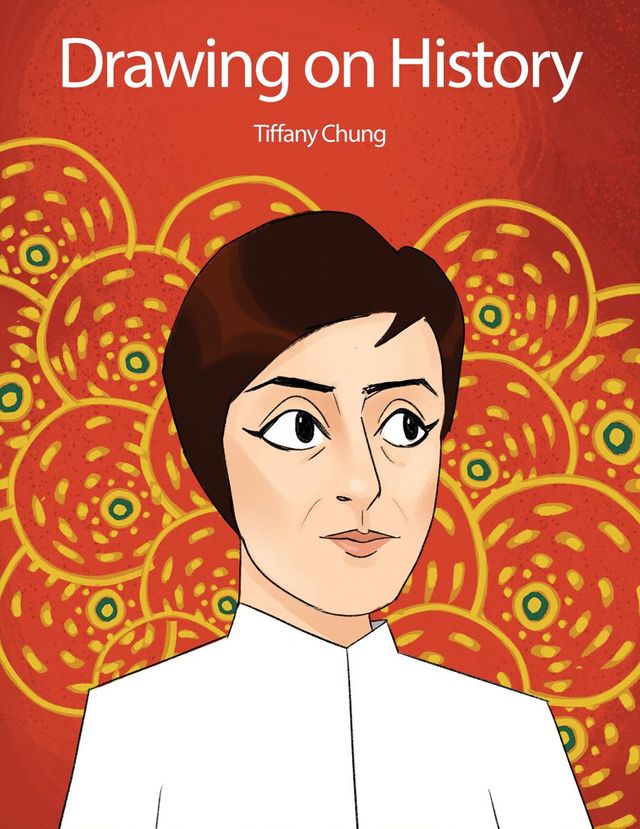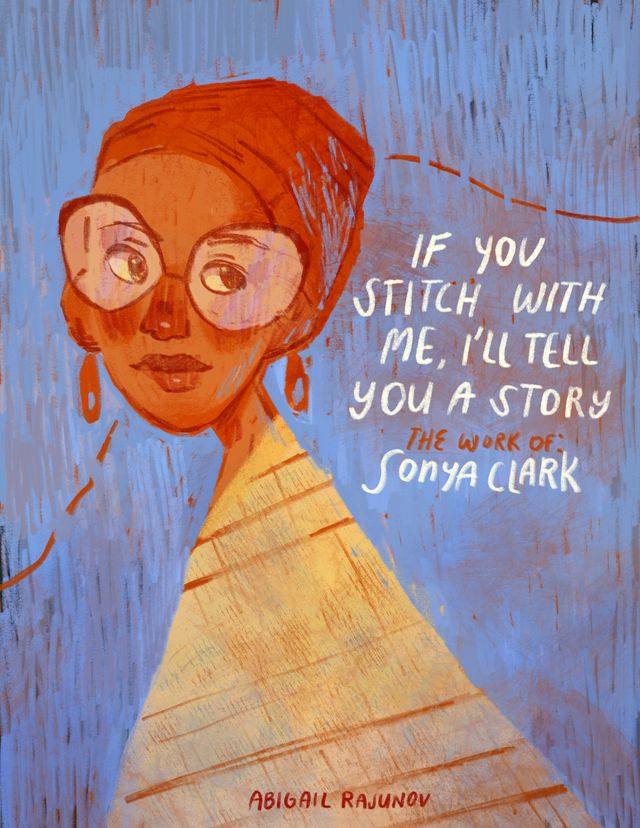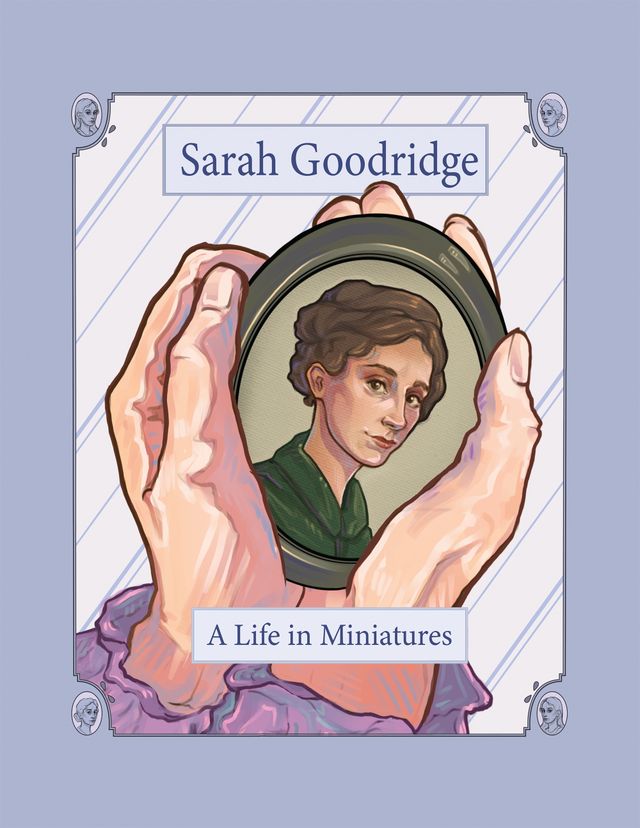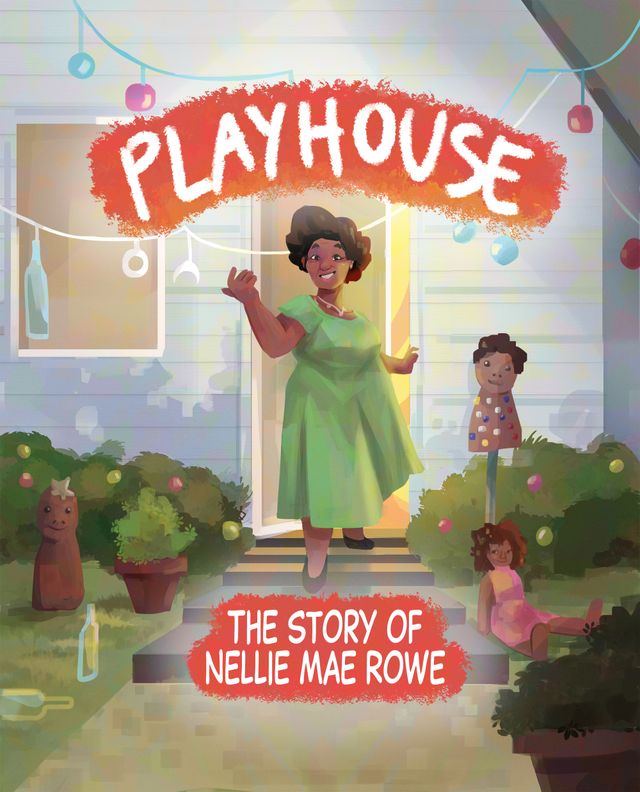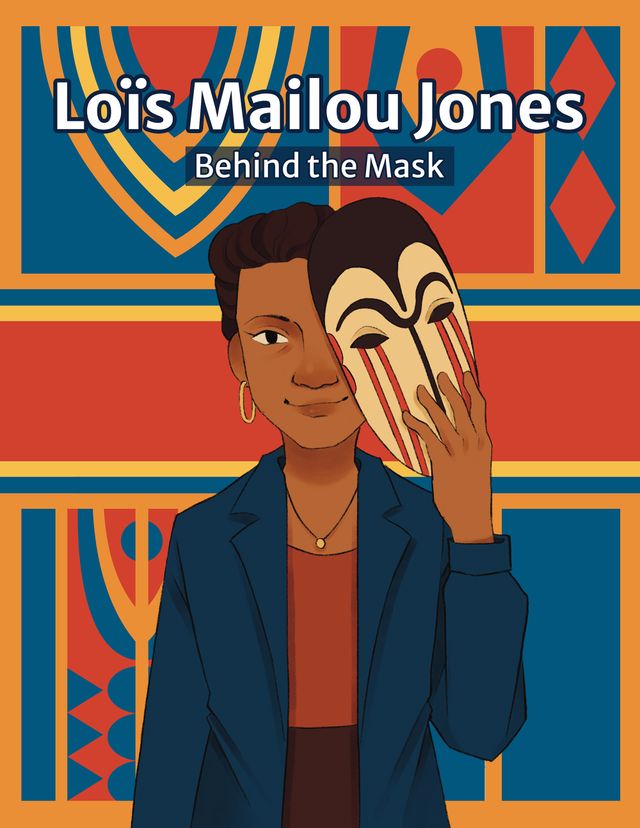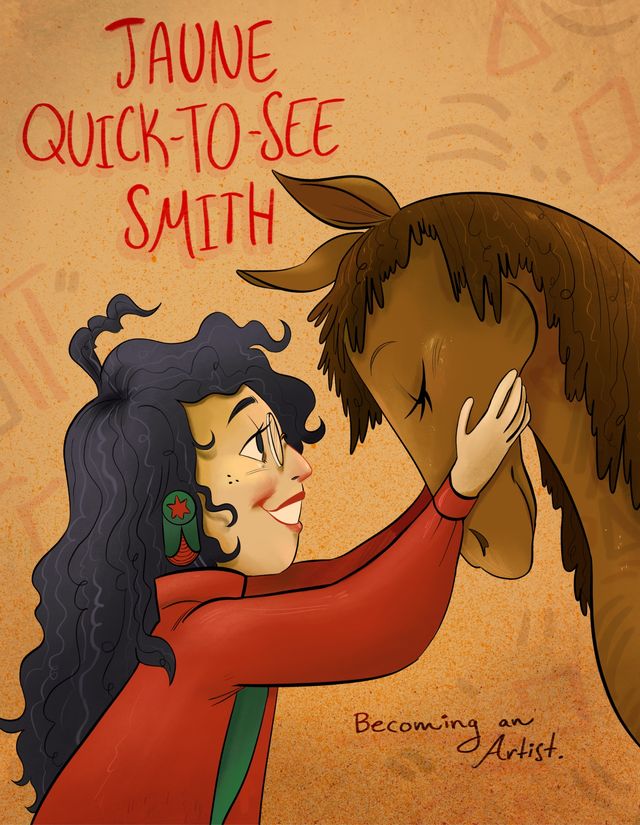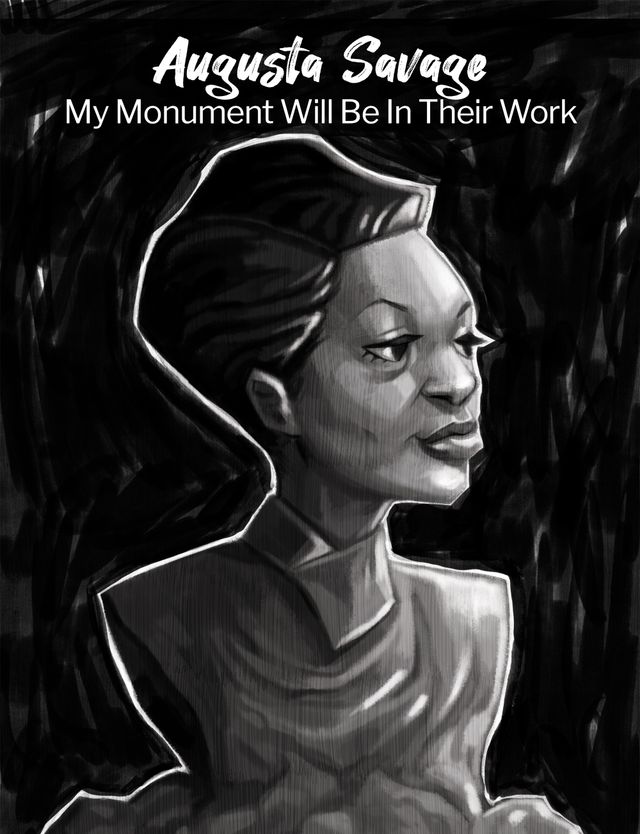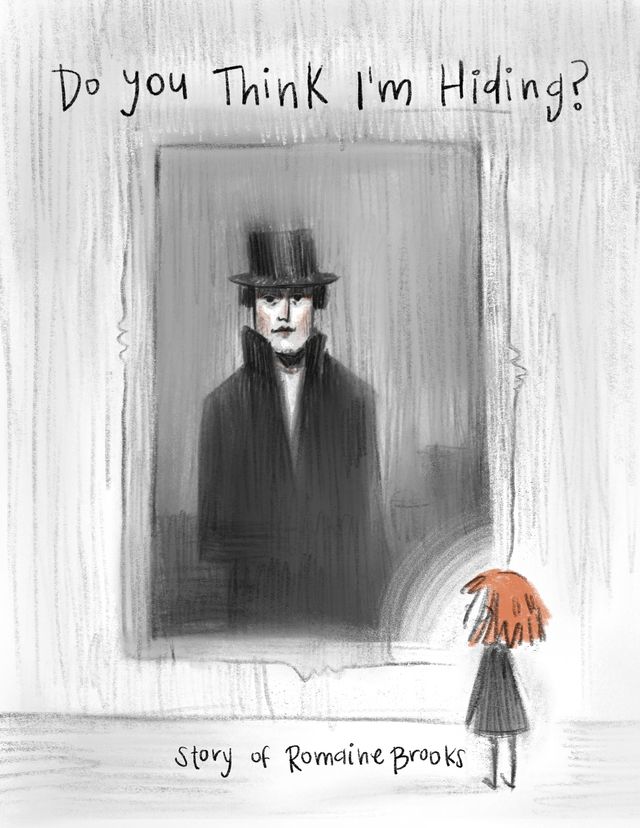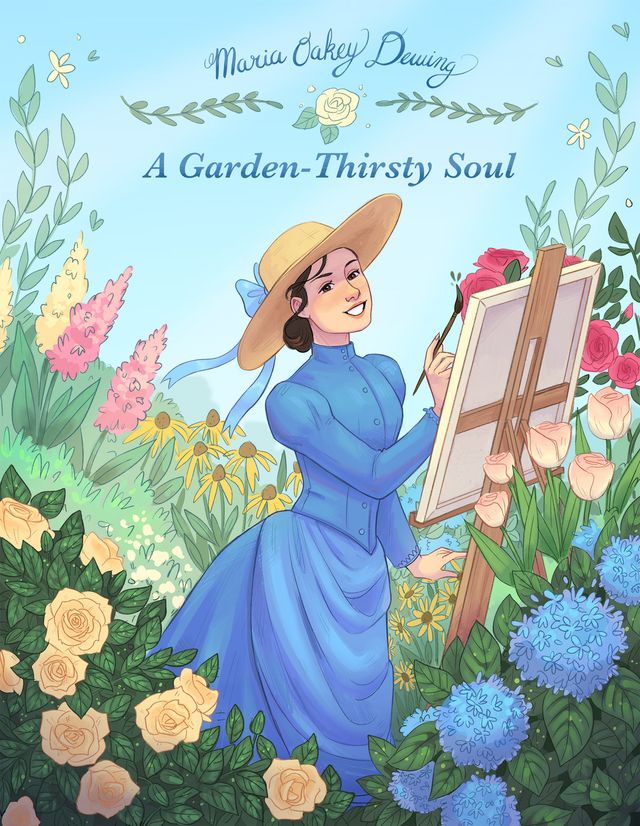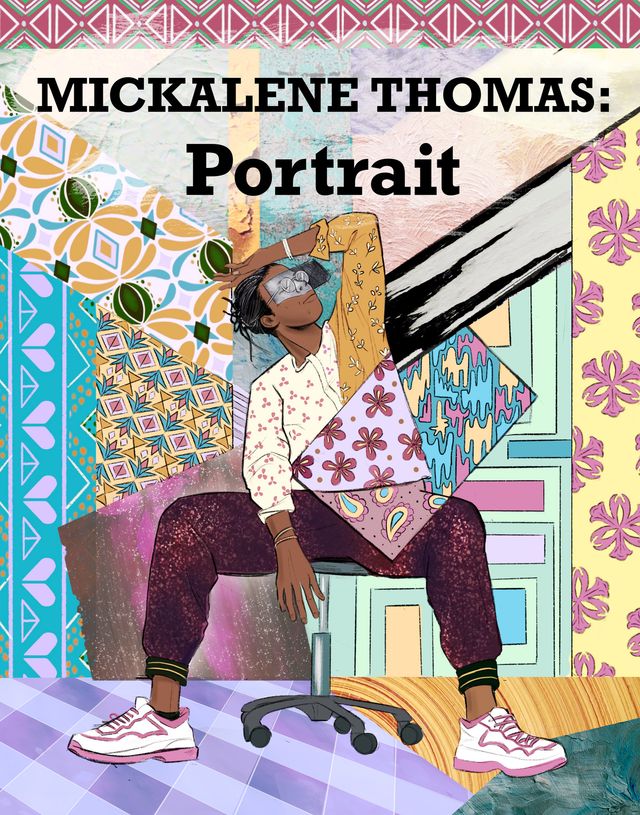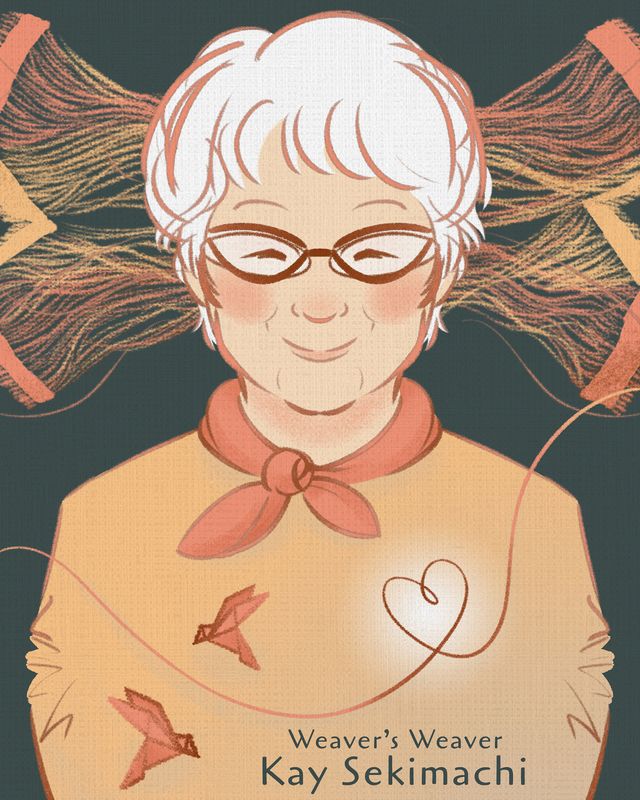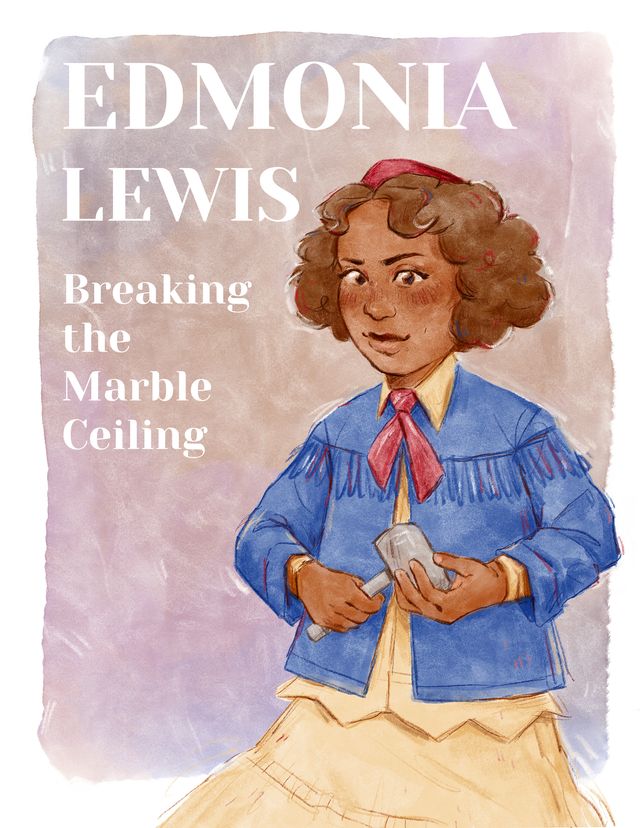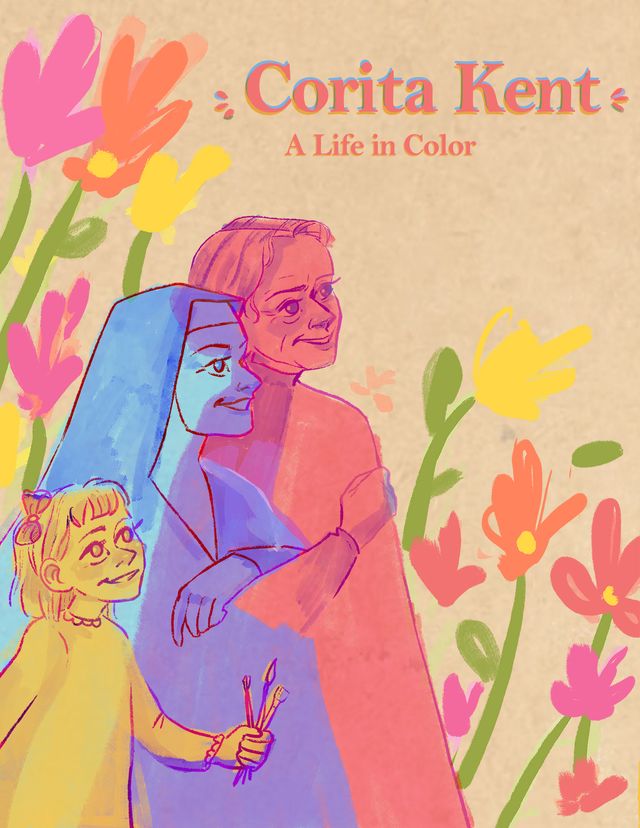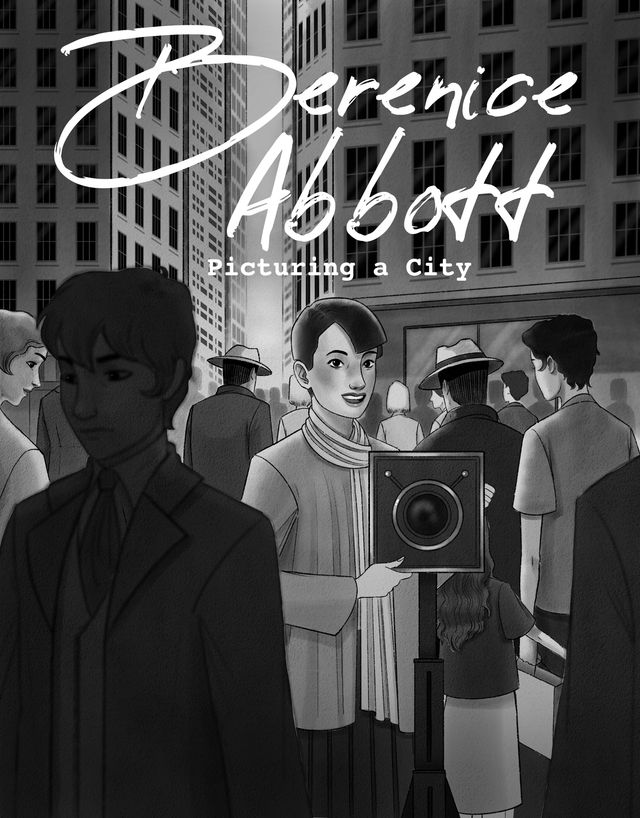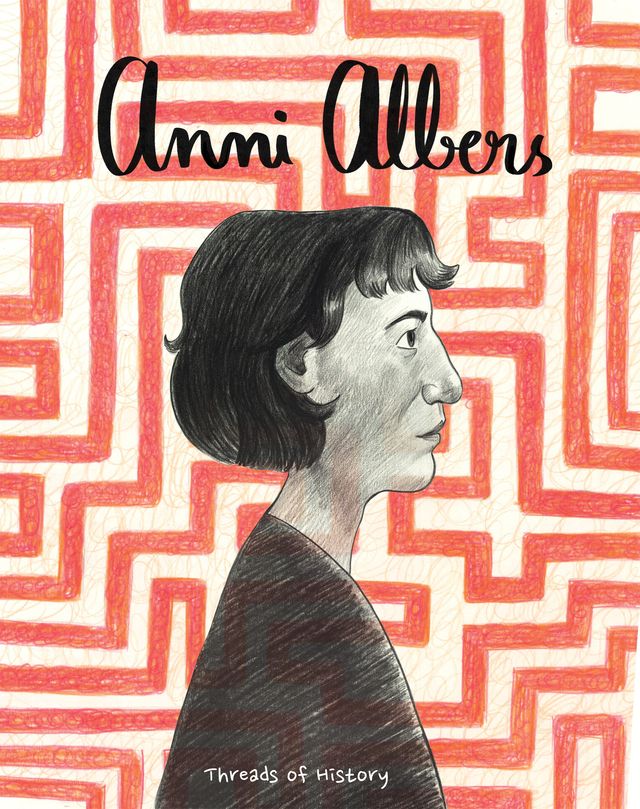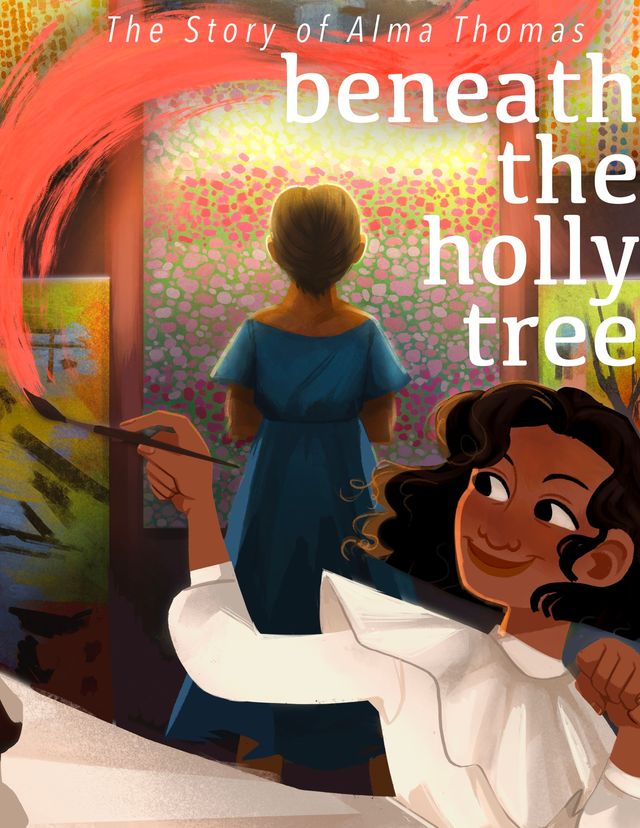An Overview
Her genre paintings of domestic scenes were filled with humor. Lilly Martin Spencer was the breadwinner for the family, making and selling paintings, while her husband stayed home with the children.
This comic is part of a series Drawn to Art: Tales of Inspiring Women Artists that illuminates the stories of women artists in the collection of the Smithsonian American Art Museum. Inspired by graphic novels, these short takes on artists’ lives were each drawn by a student-illustrator from the Ringling College of Art and Design.
We invite you to read the comic and share it with your friends and young people in your life.
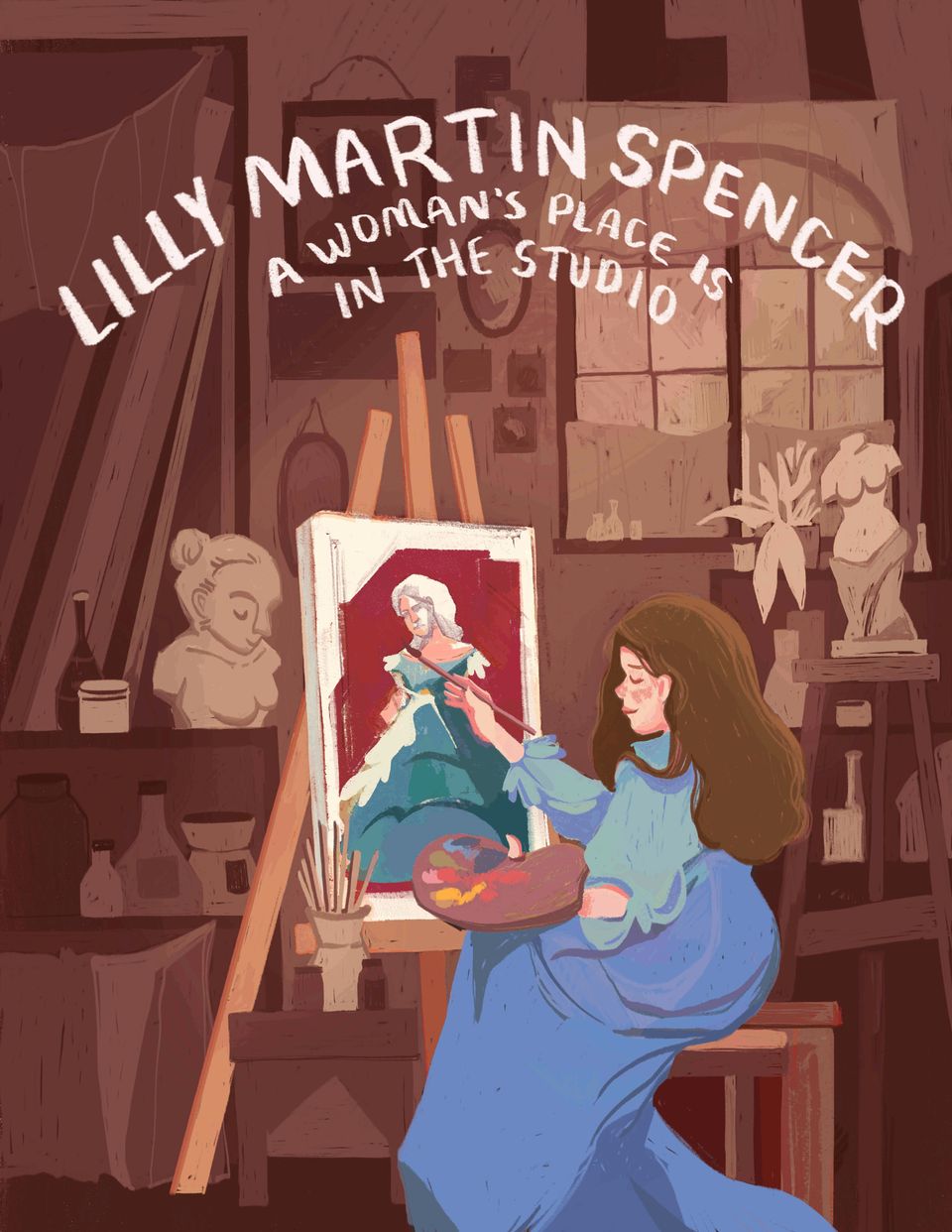
Cover
A woman sits in the center of the page looking at an easel in front of her. She has a light skin tone and long brown hair. She is wearing a loose blue long sleeve dress that fades from teal at the top to a dark periwinkle at the bottom. Her right hand is held up to the canvas painting, while her left hand holds a paint palette on her lap. The easel in front of her is a light wood color which matches the bench she's sitting on. A cup of paint brushes sits to the left of the easel. The white canvas sitting on the easel has a sketched outline of a woman in a full-length teal dress against a maroon background. In the background of the page is a brown monochrome illustration of a painting studio. To the left of the page there is a shelf containing vases and bottles; a bust of a woman's head rests on the shelf at top. Behind this are a stack of large canvases leaning against the wall. The walls are covered in paintings and mirrors and toward the right of the page is a large arched window. In front of the window Is a leafy plant and an armless and headless bust of the body a woman, draped in fabric. More shelves with vases sit under the window. White arched text over the middle of the page reads: "Lilly Martin Spencer" and underneath "A Woman’s Place is in the Studio."

Page 1
Background: This page is made up of four panels, one at top left, one at top right, one in the middle, and one along the bottom of the page. Behind the panels is a light beige background. There are three white text boxes with black text.
Panel 1
A dark green house sits in a forest landscape. The sky is dark with a shining moon and stars. In the yellow window of the house is a silhouette of a mother and father holding a baby. Light green foliage covers the foreground, obscuring the edges of the house.
Panel 2
A small girl in a frilly short-sleeved blue dress and matching shoes frolics down a wooded path. She has a light skin tone and brown hair and is smiling with her hands thrown up beside her as she runs down a light tan road. A mint green sky with fluffy white clouds sits between bushy green trees. Tall light green grass and pink flowers cover the foreground. A text box above the first two panels reads: "Born in England in 1822 to French parents, and raised on a farm in Marietta, Ohio, Lilly grew up in a progressive household. Her parents, who supported women’s rights causes, encouraged her artistic skill from a young age."
Panel 3
A young Lilly, wearing the same puff sleeve blue dress, stands haphazardly on a wooden dresser painting on the walls of her room. She stands on her right foot, reaching up with her right hand holding a brush up above her head. Her left hand holds a paint palette up by her shoulder and her left leg is kicked out to the side for balance. In front of the dresser is a small wooden table with a cup of paint brushes and water on it. To the left of the page on the white ground are more art supplies, including a few colorful pastels and a blue cup of brushes. To the right of the dresser is the end of a wooden bed frame, with a peach blanket draped across it. The light green wall that Lilly paints on is covered in drawings of people. To the left there are two images of a man with curly brown hair wearing a green shirt and pants. In one, he is holding the hand of a young girl with brown hair who is wearing a light pink puffy dress. In front of her, she paints a man in a green jacket and cap with short brown hair and a large brown mustache. He is looking to the right at the woman standing next to him who has long brown hair and is wearing a pink dress with an open green short sleeve shirt on top. Text in the upper left corner reads: "They let Lilly cover the walls of their farmhouse with portraits of her parents and two brothers - her first artwork to gain public attention."
Panel 4
This panel is a skinny horizontal strip of teal with dark green silhouettes on either side. On the left is a silhouette of a woman in a dress wheeling a cart of canvases and a man in a suit holding a briefcase, both wearing brimmed hats, walking toward the middle of the page. On the right is a silhouette of three women in dresses painting on canvases set in front of them on easels. Text in the center reads: "At nineteen, Lilly moved with her father to Cincinnati to pursue a career as a painter. There, she trained with local artists and exhibited her work."

Page 2
Background: This page is made of four overlapping panels. One is along the top third of the page, one in the left middle, and one along the right middle that overlaps with the one along the bottom third of the page. There are three white text boxes with black text.
Panel 1
A large family holds one another other against a light mint green background. In the center is a man with a light skin tone, brown hair and a brown mustache who is wearing a blue shirt. To the right is a woman with a light skin tone and long brown hair wearing a blue dress. Around them are seven children with light skin tones and brown hair all leaning in to hug their parents. Scattered between the children drawn in color are six children drawn as white silhouettes, who also have their arms stretched hugging the family. Text at the top reads: "Three years later, Lilly married Benjamin Rush Spencer. They had thirteen children, but sadly, only seven would survive into adulthood."
Panel 2
A man with short brown hair and a large brown mustache sits in a wooden rocking chair. He is wearing a dark green robe and looks down at the baby he is holding who is swaddled in a light green blanket and is wearing a matching hat. To the left of the panel is a small boy with short brown hair who is wearing a long-sleeved olive shirt and light green pants. His left hand reaches out to touch the baby. To the right of the man in the center are two small girls, both with shoulder-length brown hair. The one on the left is wearing a frilly light green dress and is reaching her left hand out to touch the baby. The girl on the right is wearing a pink short-sleeved dress and has her right hand up touching the baby. Behind the family is a light and dark brown wall. Text above them reads: "At the time it was common for women to run their household and care for their children while their husband supported the family financially. Lilly and Benjamin were different. Benjamin gave up his work as a tailor to stay at home with their children and support Lilly who was the primary earner for their family."
Panel 3
This panel overlaps with the other three on the page. It is an illustration of a yellow desktop. On the left corner of the desk there is a wooden paint palette with rainbow colors dolloped on it. A paintbrush rests on the palette, with its bristles getting red paint on the yellow tabletop. Behind the palette is another paintbrush, this time dipped into green, resting on the desk. A still life of flowers in a vase rest on the back edge of the table. There is a large pink lily in the center, surrounded by green leaves and other pink and periwinkle flowers. On the right side of the desk is a small wooden leaning easel with a white page resting on it. The paper has a painting of the still life sketched on it. In front of the easel are more paint brushes and paint tubes, staining the yellow table.
Panel 4
Three paintings are displayed in a gallery against a light brown wall. On the left is a still life of a vase of flowers, with one large pink lily in the center, set against a dark green background. It is mounted in a curvy wooden frame and is standing on a wooden easel. In the middle is another still life, this time of a bunch of apples draped over a rocky nature scene. It is framed in a light wood ornate frame and mounted against the brown wall. On the right is a still life of a bundle of roses laying against a maroon background. It is framed in a light wood simple rectangular frame and has wall text under it mounted on the wall. The brown wall hits the white floor under it, and a wooden dresser sits on the right side of the page under the edge of the third painting. Text under the paintings reads: "In 1849, The Spencer's moved to New York, where Lilly could display and sell her paintings to a larger market. There, Lilly gained recognition and acclaim for her genre paintings, many of which portrayed scenes of daily life at home."
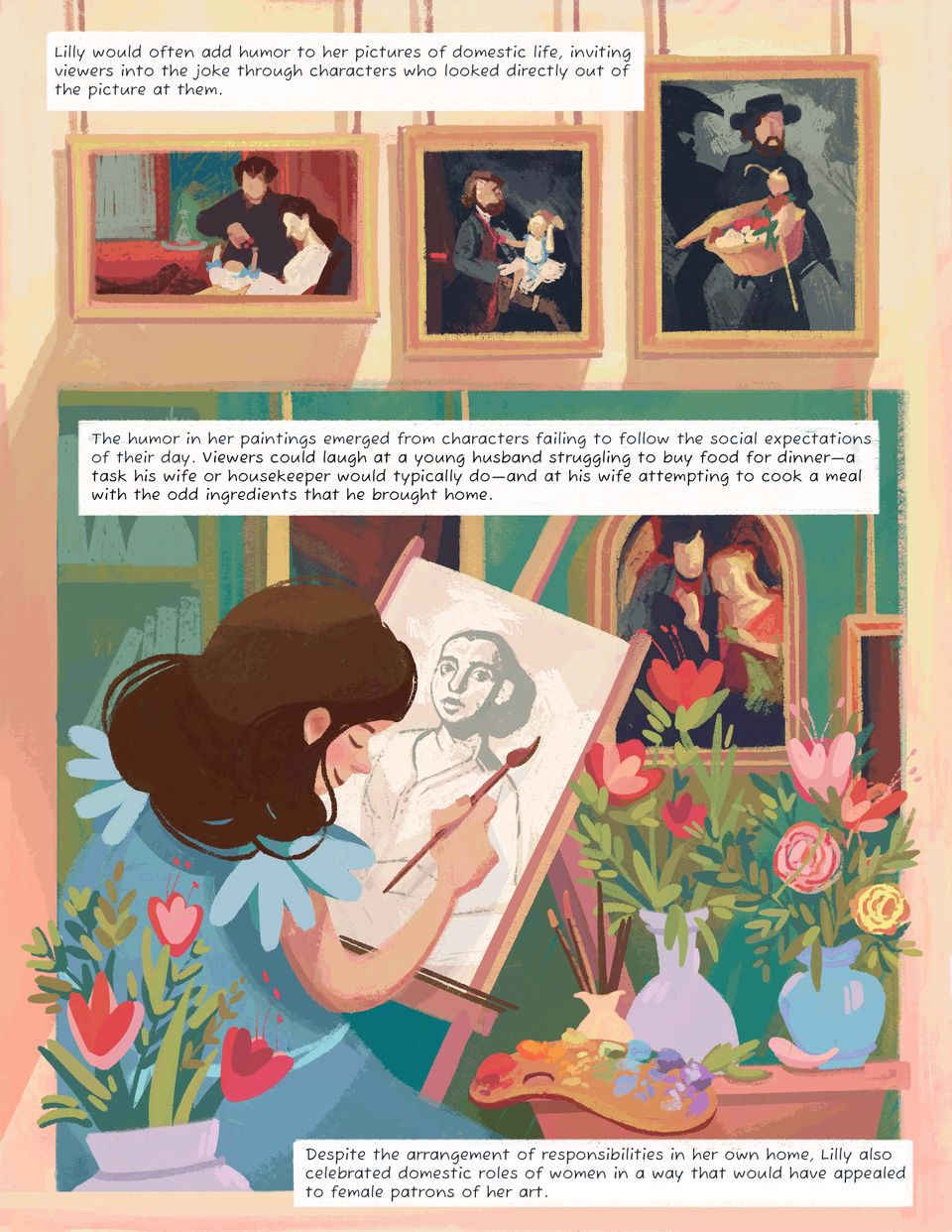
Page 3
Background: This page has two panels, one in the top third and one in the bottom two-thirds of the page. They sit against a peachy background. There are three white text boxes with black text.
Panel 1
Three paintings hang against a beige wall. On the left is Lilly's Conversation Piece, which shows a father dangling cherries over his baby who reaches up, resting on the lap of his wife. They stand in an ornate living space with a red-clothed dining table to the left of the work. In the center is Lilly's Listening to Father's Watch, which shows a young girl sitting on her father's lap smiling as she listens to the pocket watch he holds up to her ear. On the right is Lilly's First Marketing, which shows a man struggling to carry a basket of produce through a town square, as another man behind him laughs. Text reads: "Lilly would often add humor to her pictures of domestic life, inviting viewers into the joke through characters who looked directly out of the picture at them."
Panel 2
A young adult Lilly sits smiling on the left side of the panel. She holds a paintbrush up to a canvas resting on a wooden easel in front of her. The canvas has a sketch of a woman looking at the viewer on it. In front of Lilly in the bottom left corner is a light purple vase of red and pink flowers. To the right of the page is a wooden table with a paint palette sitting on it. The palate is covered in dollops of rainbow paint. Behind it on the table is a white vase holding paint brushes, another purple vase with red flowers, and a blue vase with pink and yellow flowers. Behind Lilly in the background is a large room with green walls. The walls have Lilly’s paintings hung on them, with a portrait of a family in an arched frame visible behind the vases of flowers on the table. An olive-green shelf with books and vases on it is on the left of the mounted paintings. Text at the top of the panel reads: "The humor in her paintings emerged from characters failing to follow the social expectations of their day. Viewers could laugh at a young husband struggling to buy food for dinner - a task his wife of housekeeper would typically do - and at his wife attempting to a cook a meal with the odd ingredients that he brought home." Text at the bottom of the panel reads: "Despite the arrangement of responsibilities in her own home, Lilly also celebrated domestic roles of women in a way that would have appealed to female patrons of her art."
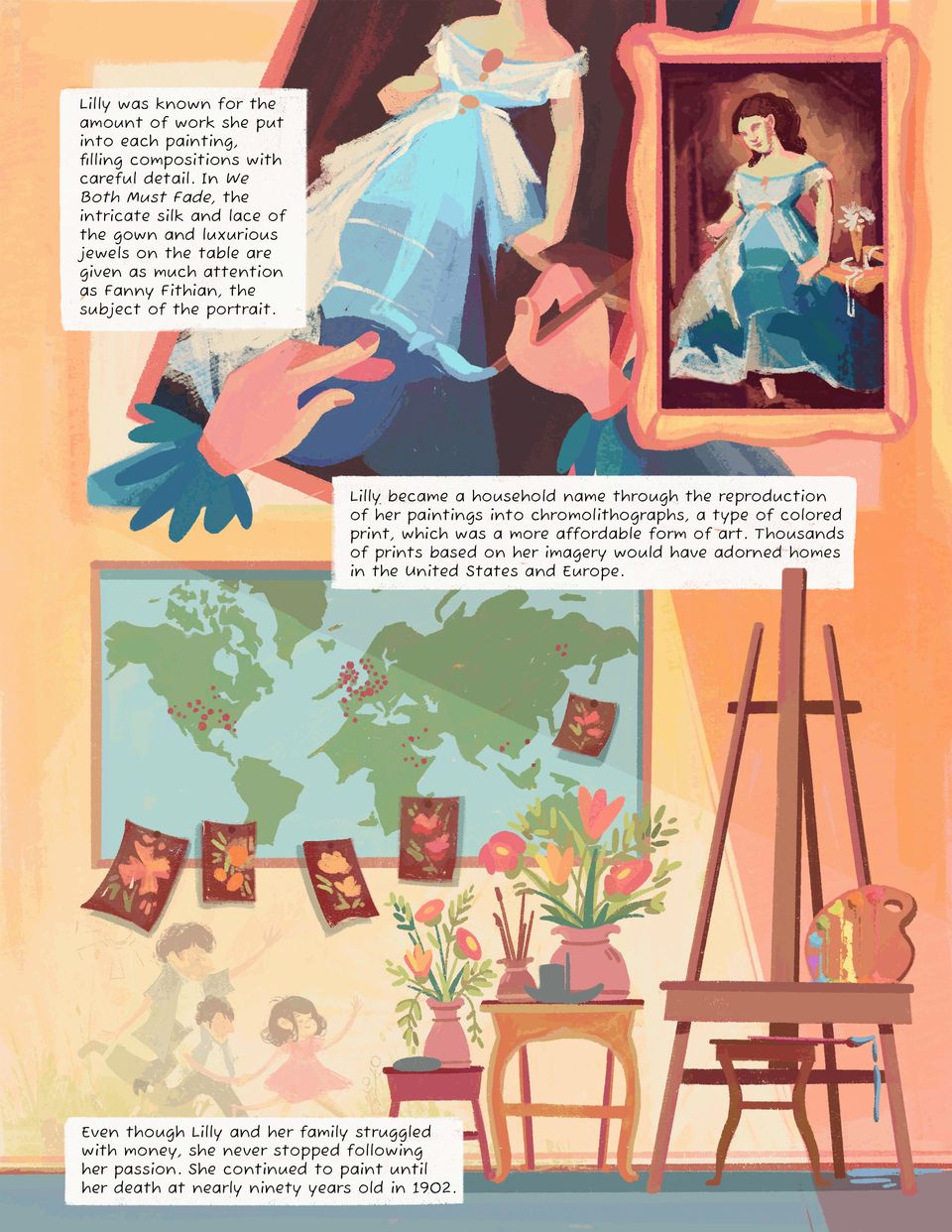
Page 4
Background: This page has two panels, one in the top half and one in the bottom half. They sit against a light orange wall that sits on a white background. There are three white text boxes with black text.
Panel 1
Lilly's hands, with frilly blue sleeve cuffs, appear from the bottom of the panel. Her right hand holds a paintbrush up to the canvas in front of her, while her left hand rests on the surface. The painting shows a woman with a light skin tone sitting on a chair wearing an ornate blue-and-white tiered dress. The sitter looks down at the ground next to a table with dying flowers next to her. A finished version of this painting, We Both Must Fade (Mrs. Fithian), hangs down from the top of the page over the illustration of Lilly painting it. It has a wavy orange wooden frame. Text on the left of the panel reads: "Lilly was known for the amount of work she put into each painting, filling compositions with careful detail. In We Both Must Fade, the intricate silk and lace of the gown and luxurious jewels on the table are given as much attention as Fanny Fithian, the subject of the portrait." Text at the bottom of the panel reads: "Lilly became a household name through the reproduction of her paintings into chromolithographs, a type of colored print, which was a more affordable form of art. Thousands of prints based on her imagery would have adorned homes in the United States and Europe."
Panel 2
This panel shows a scene of Lilly's childhood room. In the bottom left corner of the yellow wall, there are faint sketches of the man and girl she painted on the wall as a child, as seen on page one. In the center of the page there are two tables with pink vases filled with orange and pink flowers and cups of paintbrushes on them. At the right of the page is an empty large wooden easel with a dripping wooden paint palate resting against it. The wooden stool in front of the easel has a paintbrush laying on it, dripping blue paint onto the blue-gray floor. Hung on the wall is a map of the world, with small red dots added to countries across the United States, Europe, and Asia. Pinned to the map are small paintings of flower bouquets with brown backdrops. A text box in the bottom left corner reads: "Even though Lilly and her family struggled with money, she never stopped following her passion. She continued to paint until her death at nearly ninety years old in 1902."

End page
An ornate wooden table sits on a painted gradient background that goes from light peach at the top to rust orange at the bottom. The table in the center is referencing the table in We Both Must Fade and has a bouquet of colorful flowers in a brown vase in the center. Coming from a wooden jewelry box on the right side of the table is a pearl necklace. It wraps behind the vase and drapes off the front of the table. Above the left of the table brown text reads: "Illustrated by Sami Sulzer."














